VENEZIA FORMACIONE
IT: Credo che per la maggior parte delle persone che visitano la città di Venezia, una delle prime curiosità è il motivo per cui la città è stata costruita in acqua. Ogni anno che passa, ci sono sempre più immagini di inondazioni e le notizie che Venezia sta affondando, che accentua il problema. Perché qualcuno dovrebbe costruire una città in acqua? O è che il tempo della sua costruzione era terra?
EN: I believe that for most people who visit the city of Venice, one of the first curiosities is why the city was built in the water. Every passing year, there are always multiple images of floods and news that Venice is sinking, which accentuates the issue.
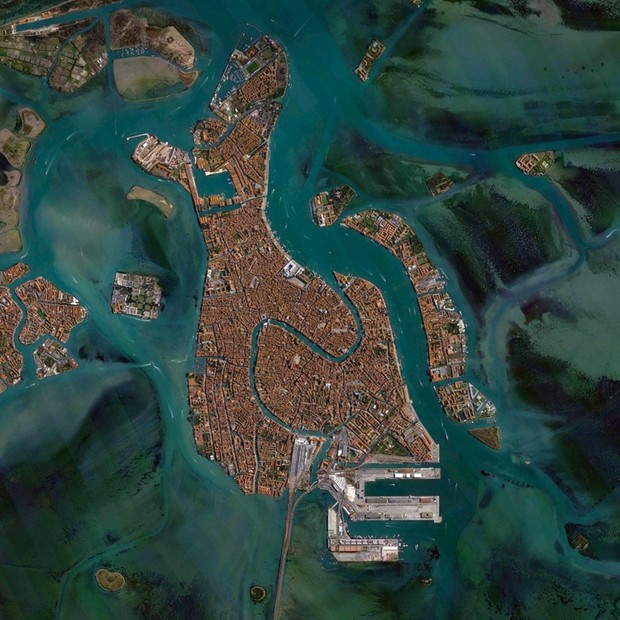
IT: In primo luogo, dobbiamo capire la formazione di Venezia. Questa città è formata in una laguna, è un termine che in geomorfologia, designa una depressione formata da salmastra o salata vicino al bordo costiera, comunicante con il mare attraverso un canale. In generale, le lagune formano nella bocca oceano di fiumi, dove a causa dell'interazione con i venti e le onde, generare barre di sedimenti che si evolvono a speroni di sabbia crescenti, con il risultato di vari isolotti.
EN: First, we must understand the formation of Venice. This city is formed in a lagoon, it is a term that in geomorphology, designates a depression formed by brackish or salt near the coastal edge, communicating with the sea through a channel. In general, lagoons form in the ocean mouth of rivers, where due to the interaction with winds and waves, generate sediment bars that evolve to sandy spurs increasing, thus resulting in several islets.
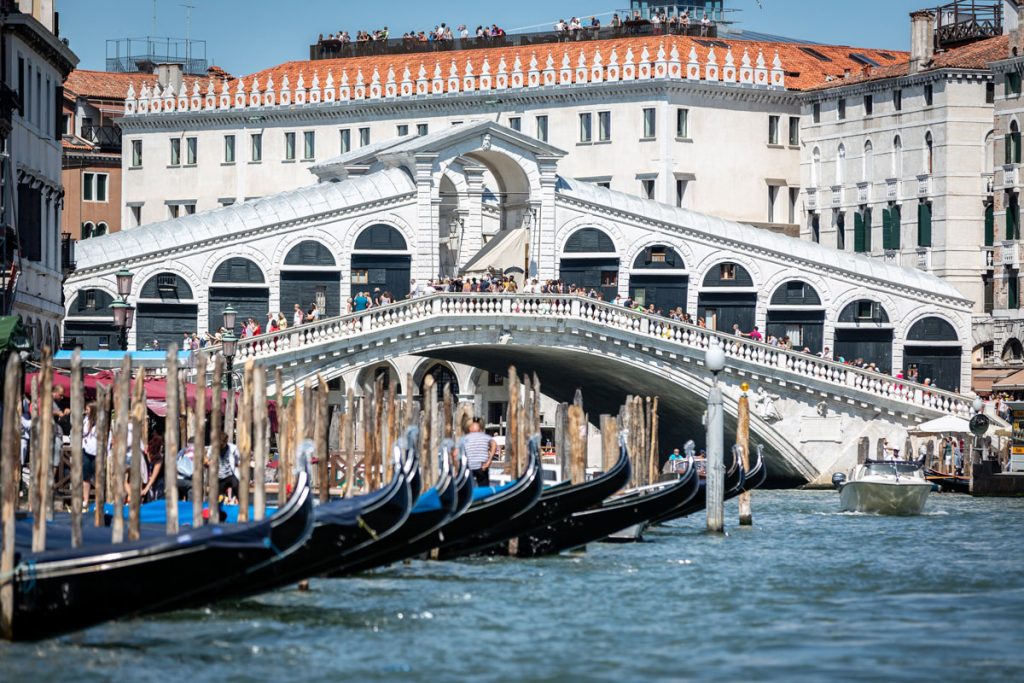
IT: Attualmente il centro storico di Venezia occupa una superficie di 7,6 chilometri quadrati ed è composto da 117 isole separate (in precedenza solo 65 isole) per 150 canali. Oltre ad essere un terreno paludoso, la compressione del suolo derivante dalla costruzione di tutta l'infrastruttura nel corso dei secoli, ha contribuito al naufragio della città.
EN: Currently the historic center of Venice occupies an area of 7.6 square kilometers and consists of 117 separate islands (formerly only 65 islands) for 150 channels. Besides being a marshland, the compression of the soil resulting from the construction of the entire infrastructure over the centuries, contributed to the sinking of the city.
IT: La città affondò quasi 23 cm negli ultimi 100 anni. Attualmente, quando la marea si alza più di 80 cm a Venezia, luoghi come Piazza San Marco e il bordo inferiore dei canali sono allagate. Aumento delle inondazioni e dei problemi che hanno causato. In certi momenti, turisti e locali sono costretti a camminare in acqua alle ginocchia.
EN: The city sank almost 23 cm in the last 100 years. Currently, when the tide rises more than 80 cm in Venice, places like St. Mark's Square and the lower edges of the channels are flooded. Increased flooding and the problems they have caused. At certain times, tourists and locals are forced to walk in knee-deep water.
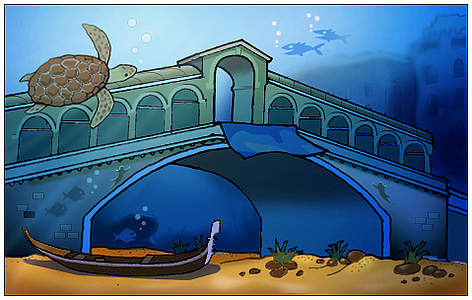
LA NATURA DELLE CAUSE
IT: Uno dei principali problemi attuali di Venezia è la città ad essere affondare, e il livello del mare, per diverse ragioni, tra cui il riscaldamento globale, è in aumento. Venezia affonda 0,4 mm all'anno. Ma il grosso problema è che il livello del mare Adriatico aumentato 1.4 mm per anno nel secolo scorso.
EN: One of the major current problems of Venice is the city to be sinking, and the sea level, for several reasons, including global warming, is rising. Venice sinks 0.4 mm per year. But the big problem is that the Adriatic sea level rose 1.4 mm per year in the last century.
IT: Il fenomeno "acqua alta" è il nome dato ai più alti rispetto al normale livello delle acque che invadono la città di Venezia, provocando le lagune sale acqua a traboccare i bordi dei canali e inondare i percorsi pedonali. Se i livelli salgono a sufficienza, bassi edifici di menzogne hanno le loro aree al piano terra riempite con l'acqua salmastra e con il riflusso di canali di scolo, come fogne riempire anche con i liquidi in eccesso ha portato con la marea.
EN:The phenomenon “Acqua alta” is the name given to the higher than normal water levels that invade the city of Venice, causing the lagoon's salt water to overflow the edges of the canals and flood the pedestrian walkways. If the levels rise sufficiently, low lying buildings also have their ground floor areas filled with the brackish water and with the backflow of drains as the sewers also fill with the excessive liquids brought in with the tide.
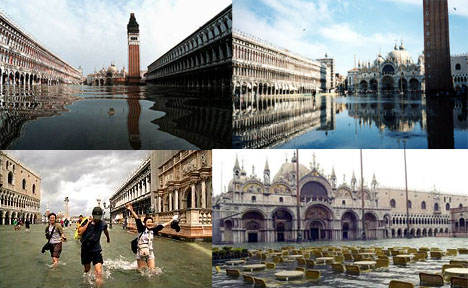
IT: Acqua Alta è una esacerbazione dei normali livelli di alta marea astronomica ("Alta Marea" in italiano), influenzato da una serie di altri fattori, come il vento, la pioggia e la pressione barometrica. Come tale, il livello di acqua alta corrisponde generalmente con le maree astronomiche, e segue un programma di sei ore crescenti e sei ore caduta, con una delle maree generalmente superiori rispetto agli altri. Alti livelli di acqua sono considerati "acqua alta", quando si alzano più di 80 centimetri sopra il livello del mare, che è il livello del suolo più basso in più tutta Venezia.
EN: Acqua alta is an exacerbation of the normal astronomical high tide levels (“alta marea” in Italian), influenced by a number of other factors, such as wind, rain and barometric pressure. As such, the level of acqua alta generally corresponds with the astronomical tides, and follows a schedule of six hours rising and six hours falling, with one of the tides generally higher than the other. High water levels are considered “acqua alta” when they rise more than 80cm above sea level, which is the lowest ground level in most all of Venice.
IT: Secondo gli esperti, alcune delle cause di tutto questo è naturale, il movimento delle placche tettoniche porta a Venezia affondamento e questo processo geologico "spingere" verso il basso. Già il riscaldamento globale sarebbe il principale responsabile per l'aumento del livello del lago e inondazioni di conseguenza.
EN: According to experts, some of the causes of all this is natural, the movement of tectonic plates leads to Venice sinking and this geological process to "push" down. Already global warming would be primarily responsible for the increase in lake level and consequently floods.

IT: Così spiega la causa naturale delle placche tettoniche. La placca adriatica, che comprende Venezia, subducts sotto le montagne dell'Appennino e fa sì che la città ei suoi dintorni a diminuire leggermente in elevazione. E anche se il pompaggio falda è fermato, la compattazione dei sedimenti sotto Venezia rimane un fattore. Questo ha l'effetto di abbassare Venezia ad una velocità di circa 1 mm all'anno.
EN: So explaining the natural cause of the plate tectonics, the Adriatic plate, which includes Venice, subducts beneath the Apennines Mountains and causes the city and its environs to drop slightly in elevation. And although the groundwater pumping has stopped, the compaction of the sediments beneath Venice remains a factor. This has the effect of lowering Venice at a rate of about 1 mm per year.

IT: L'altra causa naturale è il riscaldamento globale, che è l'aumento della temperatura media del pianeta Terra, provocando cambiamenti nel clima di alcune regioni, intensificando i fenomeni naturali come gli uragani e siccità, tra gli altri. Questi aumenti di temperatura in tutto il mondo, hanno origine le regioni ghiacciai si sciolgono con un conseguente significativo aumento del livello del mare.
EN: The other natural cause is global warming which is the increase in average temperature of the planet Earth, causing changes in the climate of some regions, intensifying natural phenomena such as hurricanes and droughts, among others. These temperature increases worldwide, originate the regions glaciers melt resulting in a significant rise in sea levels.
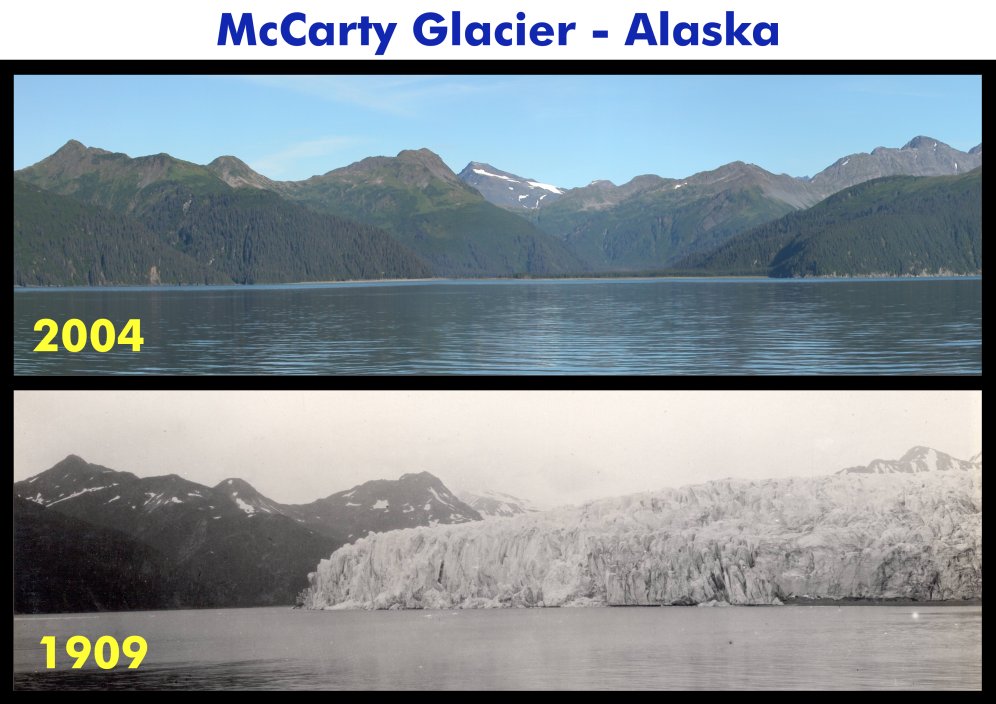
IT: L'azione dell'uomo peggiora la situazione: negli anni '30 create zone industriali che sono stati utilizzati per le acque sotterranee pompaggio dal 1960 inquina l'acqua con barche (erosione chimica) e per lungo tempo cercando di proteggere la città deviando il corso di fiumi, che possono accelerare erosione fisica del terreno. Il fondo del lago, che aveva una consistenza ruvida vegetale, è semplice: si rimuove la protezione delle infiltrazioni d'acqua della città.
EN: The action of man makes the situation worse: in the 30s created industrial zones that have been used for groundwater pumping since the 1960s pollutes the water with boats (chemical erosion) and for a long time trying to protect the city by diverting the course of rivers, which can accelerate physical erosion of the ground. The lake bottom, which had a roughened texture vegetable, is plain: it unprotects the city water infiltration.
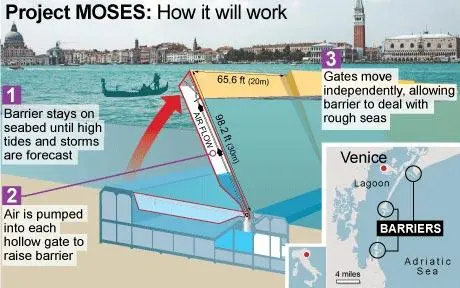
IT: Il primo piano dell'edificio è stato a lungo inutilizzato a causa di ripetute inondazioni. L'acqua entra nelle case attraverso i tubi di fogna e corrode le pareti che non erano disposti a bagnarsi. Nel 2002, ha approvato il Mosè di progetto, che prevede la realizzazione di cancelli sommersi che, una volta sollevato, sono in grado di bloccare i 3 ingressi dal mare alla laguna di Venezia.
EN: The first floor in the building has long been unused because of repeated flooding. The water enters the houses through the sewer pipes and corrode walls that were not prepared to get wet. In 2002 it approved the Project Moses, which includes the construction of submerged gates that, when raised, are able to block the 3 inputs from the sea to the Venice Lagoon.
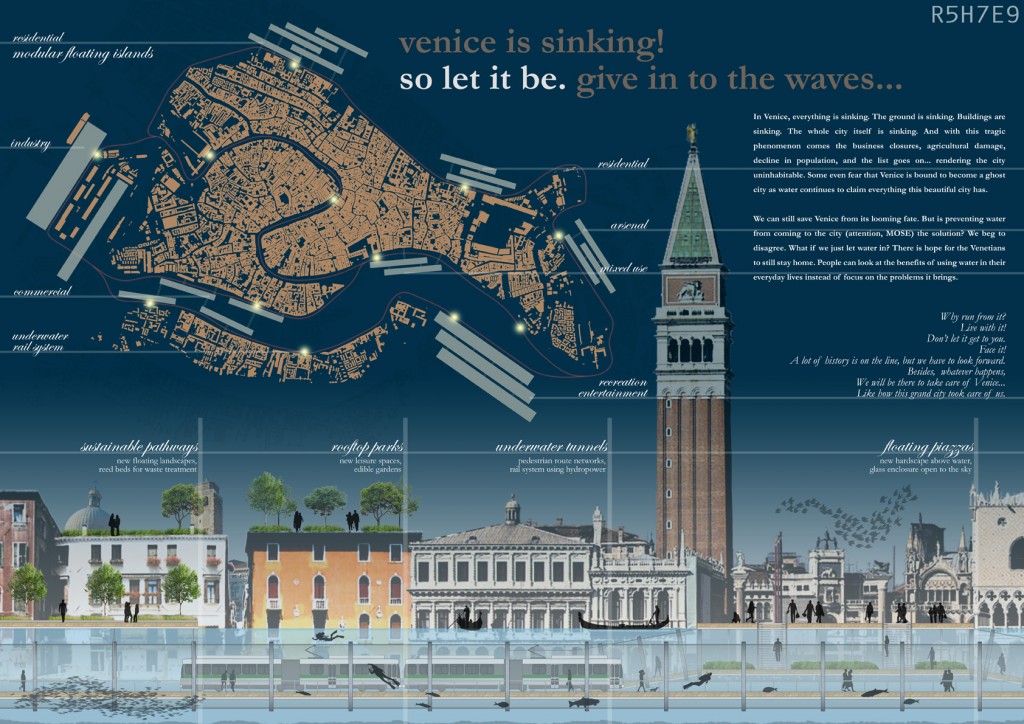
IT: Attualmente siamo in grado di osservare gli effetti che corrispondono ai movimenti delle placche tettoniche e delle cause, e trovare in mattoni coperto le voci, per quello che sarebbe l'ingresso principale della casa, che avrebbe lo spazio per la gondola e poi le scale per salire, è attualmente sommersi in acqua. Ora la porta è una porta più. Il livello più basso di questa casa è ora un seminterrato molto umida, e l'ingresso è attraverso un passaggio più recente di collegamento da quello che è diventato il nuovo porta verso il lato opposto del canale.
EN: Currently we can observe the effects corresponding to the movements of tectonic plates and subsequent causes, and find brick covered entries, for what would be the main entrance of the house, which would have space for the gondola and then some stairs to climb, is currently submerged in the water. Now the door is a door no more. The lower level of this home is now a very wet basement, and the entrance is through a more recent passage connecting from what has become the new front door down to the opposite side of the canal.
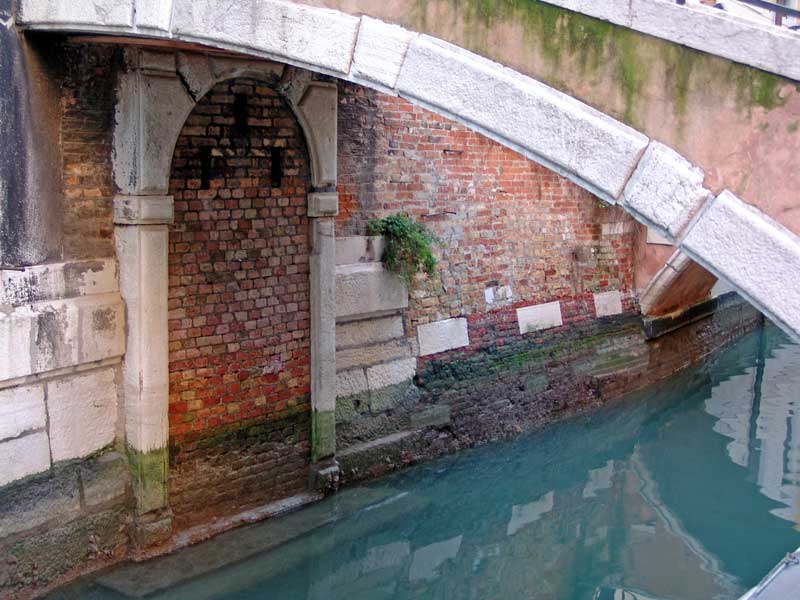
IT:
Domande:
1 - Dite quello che si intende per Laguna? Spiegare come si forma?
2 - Come affonda che Venezia ogni anno? Qual è il livello di rosa l'Adriatico un anno nel secolo scorso?
3 - Quali sono le due cause per l'affondamento di Venezia?
4 - Spiega con parole tue le cause di rispondere alla domanda precedente?
5 - Spiegare ciò che costituisce il fenomeno "Acqua Alta"?
6 - In GZ e guardando i piani indicano se preavviso di eventuali irregolarità, che tipo di roccia è composta intero piano, le dimensioni dei blocchi di pavimentazione ed i loro colori? Tell è anche marchi di acqua sulle pareti di edifici che sono in giro?
7 - Scatto di una foto in GZ con il GPS (opzionale).
EN:
Questions:
1 - What is a lagoon? Explain how it is formed.
2 - At what rate does Venice sink each year? How much has the Adriatic risen each year over the past century?
3 - What are the two causes for the sinking of Venice?
4 - Explain in your own words the causes to answer the previous question?
5 - Explain what constitutes the phenomenon "Acqua Alta"?
6 - In GZ and watching the floors indicate whether notice of any irregularity, what kind of rock is composed entire floor, the dimensions of the paving blocks and their colors? Tell is also water marks on the walls of buildings that are around?
7 - Take a picture in GZ with your GPS (optional).